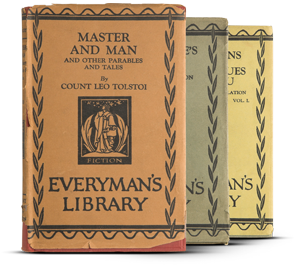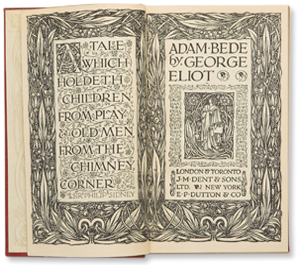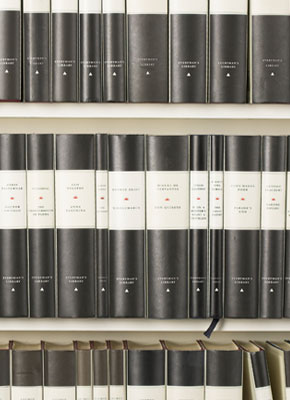THE FOUNDING OF THE EVERYMAN'S LIBRARY

Abstract wood-engraved ornaments
by Eric Ravilious (1903-42)
Everyman's Library was founded on 15th February 1906 with the publication by Joseph Dent (1849–1926) of fifty titles. Dent, a master bookbinder turned publisher, was a classic Victorian autodidact. The tenth child of a Darlington house-painter, he had left school at thirteen, and arrived in London with a half crown in his pocket. He promised to publish new and beautiful editions of the world’s classics at one shilling a volume, ‘to appeal to every kind of reader: the worker, the student, the cultured man, the child, the man and the woman’ so that ‘for a few shillings the reader may have a whole bookshelf of the immortals; for five pounds (which will procure him a hundred volumes) a man may be intellectually rich for life’. ‘Infinite riches in a little room’, as he also put it.
Popular classic series had existed before, but none was on the scale of Everyman’s Library. As John Gross wrote in The Rise and Fall of the Man of Letters, ‘Other reprint publishers merely published reprints; Everyman’s Library was an institution, a benign presence, a crusade, an act of faith.’ Milton’s words, ‘A good book is the precious life-blood of a master spirit, embalmed and treasured up on purpose to a life beyond life’ were printed on the title-pages of the first two Everyman volumes, Boswell’s Life of Samuel Johnson, and every Everyman title ever since has carried the motto
‘Everyman, I will go with thee, and be thy guide, In thy most need to go by thy side’
from the medieval morality play, where the character Everyman is comforted by another character, Knowledge, as he sets out on a journey, long, hard and dangerous.

Title-pages and endpapers designed
by Reginald Knowles (1879-1950)
Joseph Dent had been greatly influenced by the designs and private-press books of William Morris and T.J Cobden-Sanderson, and the title-pages and endpapers designed by Reginald L. Knowles (1879-1950) owe much to the Arts and Crafts movement. Both Aubrey Beardsley and Walter Crane had worked earlier for Dent.
The pocket format (6 11/16 x 4 1/4 inches) lasted until 1953, when the slightly larger crown octavo format was adopted; round backs replaced the original flat spines in 1928. Knowles’s designs were used for thirty years until in 1935 typeset title-pages (using Eric Gill’s Perpetua Roman face) were introduced, with small abstract wood-engraved ornaments by Eric Ravilious (1908-42). Ravilious also created a distinctive whorl design for the end-papers. In 1953 the series was again redesigned. In this year a new version of the dolphin-and-anchor trademark was engraved by Reynolds Stone and placed on the foot of the title-page; Dent had adopted many years before this emblem of the Venetian Renaissance scholar-printer Aldus Manutius, who, in the last decade of the fifteenth century, had effectively invented the pocket book with his popular editions of the classics.
Everyman paperbacks first appeared in 1960 and in 1987 J.M. Dent was acquired by Weidenfeld & Nicolson. In 1990 Everyman was sold again and in 1991 Everyman’s Library was reborn as a ‘hardback permanent library of record’ as John Updike has called it, an alternative to more ephemeral paperbacks, and now e-books, published by a small independent company, David Campbell Publishers, with the support of Random House in the UK and Alfred A. Knopf in the US. We promised fine typographic design, sewn cloth bindings with head and tail bands and a silk ribbon marker, acid-free paper which would not discolour with age, as well as substantial introductions by leading scholars and writers, and comparative chronologies in an easy-to-read format 8 1/8 x 4 7/8 inches. We decided on Jane Austen’s Pride and Prejudice as the first of fifty titles to be published for the relaunch in September 1991, and within twelve months 130 titles had appeared, including such major twentieth-century classics as Faulkner’s The Sound and the Fury, Joyce’s Ulysses, Kafka’s The Trial, Lampedusa’s The Leopard and Pasternak’s Doctor Zhivago, none of which had previously been published in Everyman.
MODERN PUBLISHING

Everyman’s Library now includes titles by Achebe, Allende, Bassani, Bellow, Borges, Bradbury, Bulgakov, Calvino, Camus, Cather, Chandler, Dahl, Eco, Penelope Fitzgerald, Forster, Grass, Greene, Hašek, Heller, Hemingway, Highsmith, Levi, Lessing, McCarthy, Mahfouz, Mann, Márquez, Maugham, Morrison, Nabokov, O’Brien, O’Connor, Orwell, Proust, Rushdie, Solzhenitsyn, Spark, Paul Scott, Steinbeck, Svevo, Updike, Waugh and Woolf, a catalogue that few publishers can rival in paperback and of course none in hardback. We have published Robert Fitzgerald’s distinguished translations of Homer and Virgil, an edition of Shakespeare with more than 700 pages of magisterial introductions by Tony Tanner, the only complete edition available in English of Vasari’s Lives of the Painters, Sculptors and Architects, Allen Mandelbaum’s fine translation of Dante’s Divine Comedy – the only edition to include Botticelli’s extraordinary pen and silverpoint drawings – the most complete one-volume Goethe in English and Richard Pevear and Larissa Volokhonsky’s ongoing great translations of the nineteenth-century Russian classics.
In 1992 we launched a series of children’s classics, bringing back into print illustrators such as Aubrey Beardsley, Ivan Bilibin, Walter Crane, Kate Greenaway, Mervyn Peake, Heath Robinson and his brother Charles. This was followed by the hugely popular Everyman’s Library Pocket Poets series which now has more than eighty titles in print. In 1993 we also launched the ambitious Everyman Guides, highly illustrated and hugely informative art and architectural guides, which in turn have been followed by the CityMap Guides which combine a pocket guidebook with maps that unfold. In 2000, on the twenty-fifth anniversary of the death of P G Wodehouse, we launched the first collected edition of the English language’s greatest comic writer. Everyman’s Library is now an imprint of Alfred A. Knopf with more than six hundred titles in print.
Between 1998 and 2006 we donated a complete set of the main Everyman series, 300 books, to every state secondary school in the UK, 4300 schools in all, as well as to 1700 schools and libraries in seventy seven countries of the developing world, with the generous support of the Millennium Commission and other charitable trusts – a total of more than 1,715,000 books with a bookshop value of more than £19,000,000. Surprisingly this was the only millennium project in the UK to celebrate the English language and its literature, or to concern schools and books.
I should like to thank all the scholars, writers, booksellers and of course the readers and the book-lovers who have bought our editions, who have made the revival of Everyman’s Library such a reality.
David Campbell
Publisher, Everyman's Library